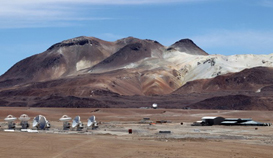Looking for the origins of the universe? Head to Chile
 The conditions optimal for studying the heavens aren’t exactly optimal for human life.
The conditions optimal for studying the heavens aren’t exactly optimal for human life.Namely, they are nosebleed-inducing high altitude, distance from cities with night-sky-polluting lights and desert conditions, where rain droplets can’t interfere with radio signals.
In short, the Atacama plateau in northern Chile.
That’s where scientists are building one of the world’s largest Earth-based astronomical projects, the Atacama Large Millimeter/submillimeter Array, known as ALMA.
By its completion next year, the $1 billion project, which opened last October, will feature 66 radio antennas spread over the 16,597-feet-high plateau in the Andes that will help scientists from all over the world study the universe’s origins.
What ALMA scientists hope to see
The project will make possible leaps in the understanding of the universe.
Instead of light waves, ALMA’s radio telescopes will detect radio waves, which allow scientists to explore dark parts of the universe, such as the stuff that forms stars — clouds of cold gas.
Scientists there will also be able to explore “cold gas tracers,” which are the ashes of exploded stars from the “cosmic dawn” — just a few hundred million years after the Big Bang.
ALMA astronomers may also be able to detect the spots where the first galaxies were formed, uncover the solar systems that could support life and even find water-holding planets.
But ALMA scientists are cautious about what they will find. “We won’t be able to see life, but perhaps signatures of life,” ALMA’s director Thijs de Graauw, a Dutch astronomer, told The New York Times.
You can return to the main Market News page, or press the Back button on your browser.

